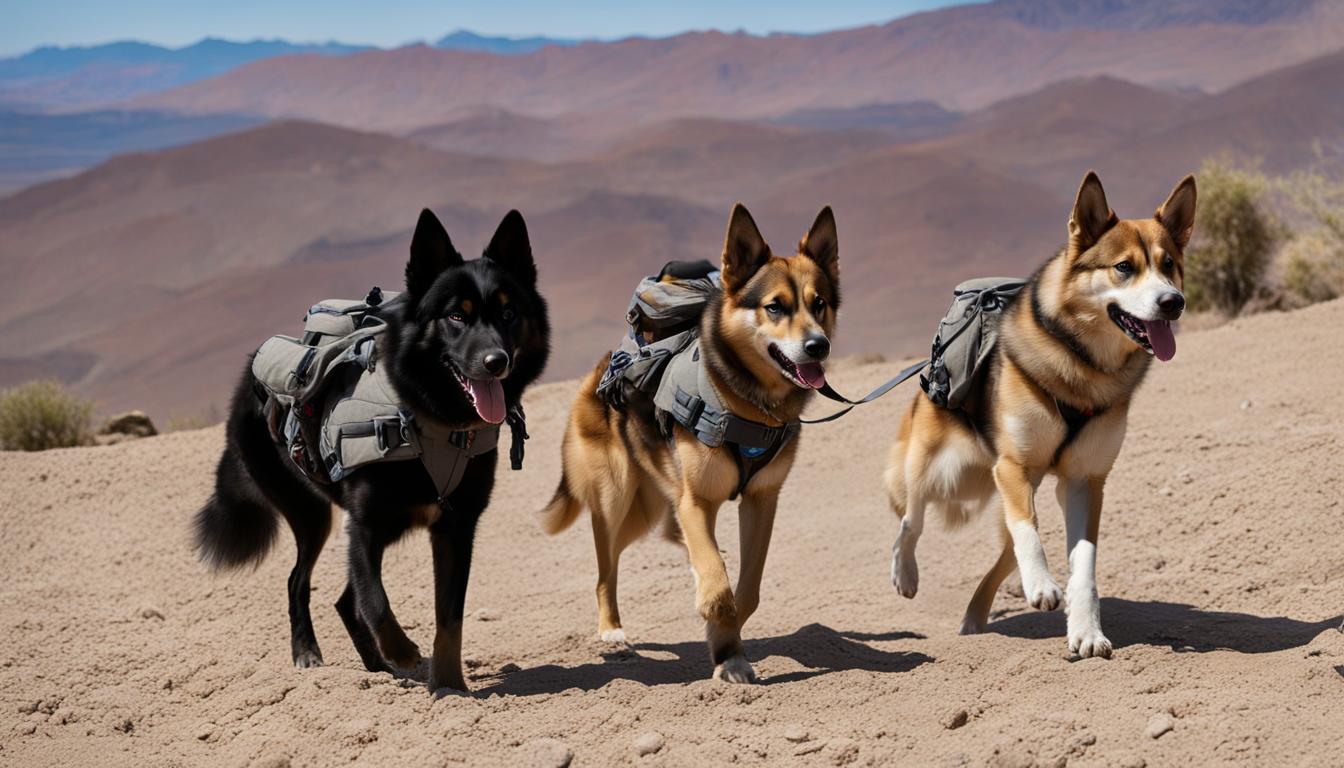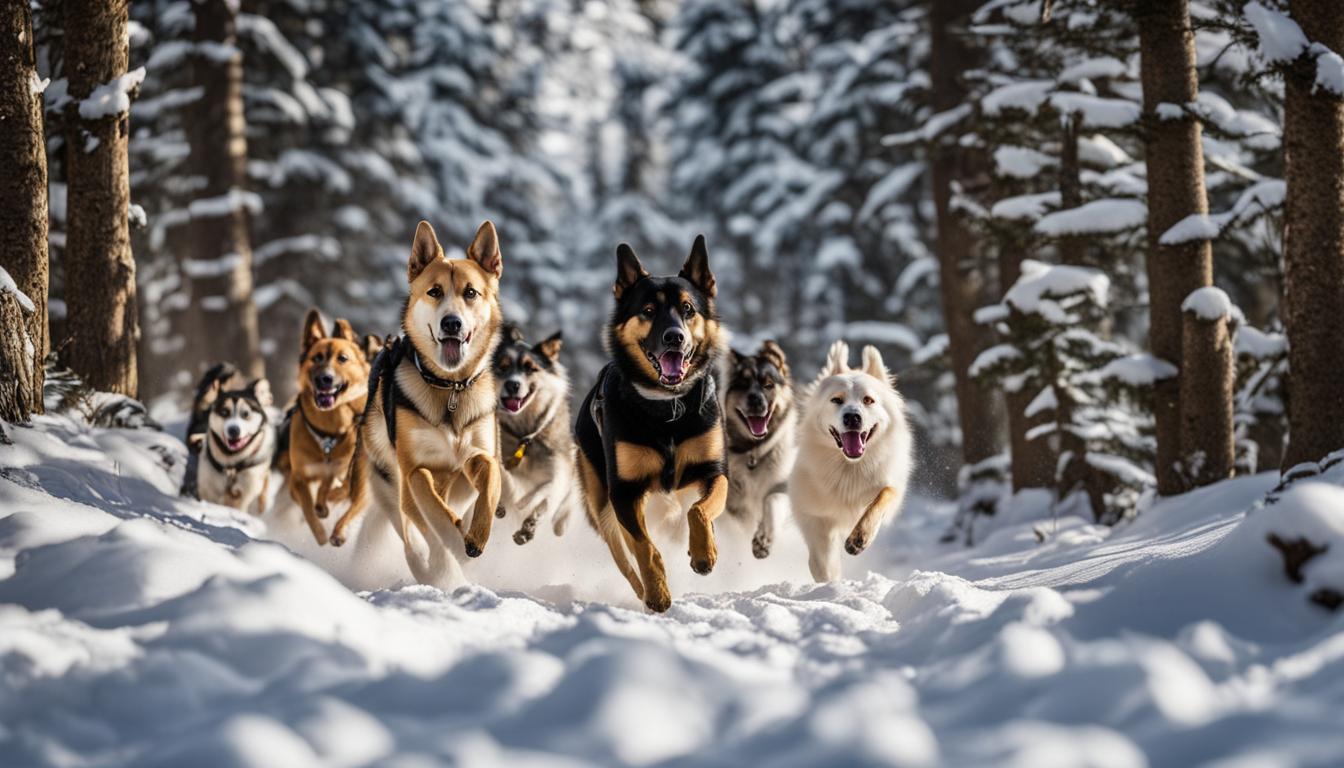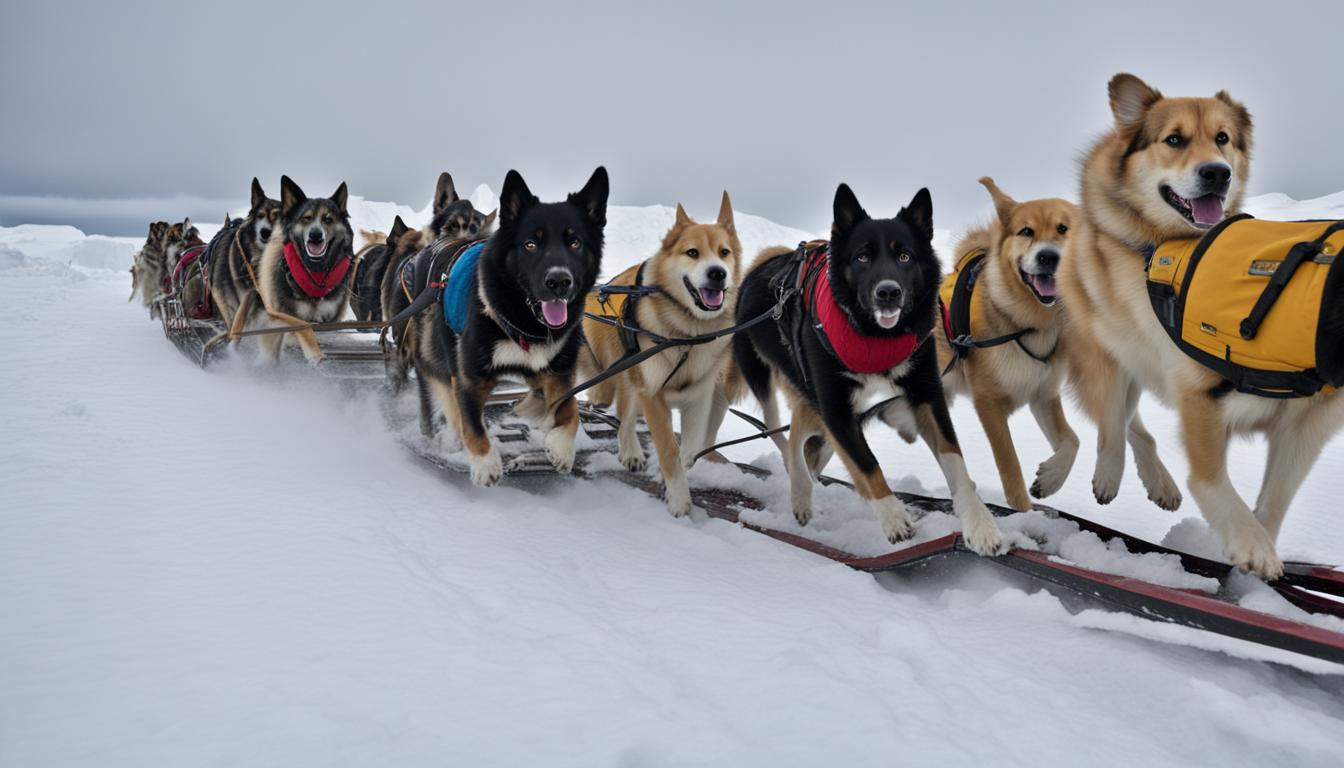Welcome to your ultimate guide to exploring the desert with a furry companion by your side! Desert Expedition Dogs are the perfect partners for embarking on thrilling adventures amidst the sandy landscapes. Whether you dream of dog sledding through the dunes or hiking through arid terrains, this guide will provide you with all the information you need to know. From adventure dog training to choosing the right dog breed for desert expeditions, we’ve got you covered.
Key Takeaways:
- Adventure dog training is essential for preparing your canine companion for desert expeditions.
- Consider the unique characteristics of desert dog breeds when selecting your expedition partner.
- Equip your dog with the necessary gear, such as protective boots, to ensure their safety in the harsh desert environment.
- Stay vigilant about your dog’s well-being during the expedition, including monitoring for signs of heat exhaustion.
- With the right training, breed selection, and safety precautions, you can embark on an unforgettable desert adventure with your furry friend.
Training Your Desert Expedition Dog
Physical preparation is crucial for a successful desert expedition with your dog. Training your desert expedition dog involves building their core muscles, improving their strength and endurance, and increasing their cardiovascular fitness. Core exercises like planks can help with balance and stability, while strength training should focus on the back, shoulders, and quads. Endurance training is essential for activities like dog sledding and cross country skiing. Cardiovascular exercises should also be incorporated into your dog’s fitness routine.
Starting early and building a routine with the help of a trainer or accountability partner can ensure your dog is physically prepared for the challenges of a desert expedition. Regular exercise and training sessions will not only enhance their performance but also strengthen the bond between you and your furry companion. With the right training and preparation, you and your desert expedition dog will be ready to take on any adventure that comes your way.
Core Exercises for Your Desert Expedition Dog
Here are some core exercises you can incorporate into your dog’s training routine:
- Planks: This exercise helps improve your dog’s balance and stability. Begin by having your dog lie down on their stomach and then lift their abdomen off the ground, supporting themselves with their forearms and toes.
- Roll-overs: Roll-overs strengthen your dog’s abdominal muscles. Encourage your dog to lie on their side and then gently roll them onto their back.
- Leg lifts: Leg lifts target your dog’s lower abdominal muscles. Start by having your dog lie on their back and then lift one leg off the ground while keeping it straight.
Strength and Endurance Training
In addition to core exercises, it’s important to incorporate strength and endurance training into your dog’s fitness routine. Here are some exercises you can try:
- Hill climbs: Find a hill or incline and encourage your dog to climb it. This will help build their leg and back muscles.
- Sprint intervals: Incorporate sprint intervals into your dog’s training sessions. This will improve their cardiovascular fitness and endurance.
- Long walks or hikes: Regular long walks or hikes will help your dog build stamina and endurance for longer desert expeditions.

Training your desert expedition dog is a rewarding journey that requires dedication and consistency. By focusing on core exercises, strength training, and endurance exercises, you can ensure that your dog is physically prepared for the challenges of a desert expedition. Remember to consult with a professional trainer or veterinarian to tailor the training program to your dog’s specific needs and abilities. With proper training, you and your furry companion will be ready to tackle any desert adventure that awaits!
Choosing the Right Dog Breed for Desert Expeditions
When embarking on a desert expedition, it is essential to choose a dog breed that is well-suited to the harsh conditions and challenges of the desert environment. Not all dog breeds are equipped to handle the extreme temperatures and demanding terrain that desert expeditions entail.
There are several factors to consider when selecting a dog breed for desert adventures. Endurance and heat tolerance are key characteristics to prioritize. Breeds like the Alaskan Malamute, Siberian Husky, and Rhodesian Ridgeback are known for their ability to thrive in desert climates due to their natural adaptations. These breeds have a higher tolerance for heat, thanks to their thick coats and ability to regulate body temperature effectively.
For those seeking expert guidance, specialized desert dog adventure tours are also available. These tours provide trained canine companions that are specifically bred and trained for desert exploration. These dogs are accustomed to the challenges of desert expeditions and can be a valuable asset during your journey. They bring a wealth of experience and knowledge to enhance your adventure and ensure a safe and enjoyable experience.
Choosing the right dog breed, whether it be a heat-tolerant breed or a canine companion from a desert adventure tour, ultimately ensures that you and your furry friend can embark on a successful and fulfilling desert expedition. By selecting a breed that is well-suited for the environment and conditions, you are setting yourself and your dog up for a remarkable and unforgettable adventure in the desert.
Table: Dog Breeds Suited for Desert Expeditions
| Breed | Heat Tolerance | Endurance |
|---|---|---|
| Alaskan Malamute | High | High |
| Siberian Husky | High | High |
| Rhodesian Ridgeback | High | High |

Safety Tips for Desert Expeditions with Dogs
When embarking on a desert expedition with your dog, safety should be your top priority. By following these essential safety tips, you can ensure a safe and enjoyable adventure for both you and your furry companion.
Choose Dog-Friendly Desert Trails
Research and select dog-friendly trails that are suitable for your dog’s fitness level and capabilities. Look for trails with moderate difficulty and terrain that won’t be too challenging for your dog to navigate. Avoid trails with steep inclines or rough terrain that could potentially lead to injuries.
Equip Your Dog with Desert Expedition Gear
Proper gear is essential to protect your dog from the harsh conditions of the desert. Invest in protective boots to shield their paws from hot sand and sharp rocks. These boots will help prevent injuries and burns. Additionally, consider getting a lightweight backpack for your dog to carry essentials like water, food, and first aid supplies. This will help distribute the weight and prevent strain on your dog’s back and joints.
Stay Hydrated and Take Regular Breaks
Hydration is crucial in the desert, both for you and your dog. Make sure to carry an ample supply of fresh water for your dog and take regular breaks in shaded areas to provide relief from the scorching sun. Watch for signs of heat exhaustion, such as excessive panting, drooling, or lethargy. If you notice any of these symptoms, find a shaded spot and allow your dog to rest and cool down.
Be Mindful of Wildlife and Other Hazards
Deserts are home to various wildlife species, some of which may pose a threat to your dog. Keep your dog on a leash and be aware of your surroundings. Avoid contact with snakes, scorpions, and other potentially dangerous desert creatures. Additionally, be cautious of cacti and thorny plants that could cause injury. Carry a pet-friendly first aid kit to treat minor injuries promptly.
“Adventure is worthwhile, especially when shared with your furry friend. Ensure their safety and happiness by following these simple guidelines and embark on a desert expedition filled with unforgettable moments.” – Unknown
By following these safety tips, you can have a safe and enjoyable desert expedition with your dog. Remember to choose dog-friendly trails, equip your dog with the right gear, stay hydrated, and be mindful of potential hazards. With proper preparation and care, you and your canine companion can create incredible memories together in the vast and breathtaking beauty of the desert.
| Safety Tips for Desert Expeditions with Dogs | Summary |
|---|---|
| Choose Dog-Friendly Desert Trails | Research and select trails suitable for your dog’s fitness level and capabilities. |
| Equip Your Dog with Desert Expedition Gear | Invest in protective boots and a lightweight backpack for your dog’s safety and comfort. |
| Stay Hydrated and Take Regular Breaks | Ensure your dog has access to fresh water and take breaks in shaded areas to prevent heat exhaustion. |
| Be Mindful of Wildlife and Other Hazards | Keep your dog on a leash, avoid contact with dangerous wildlife, and be cautious of thorny plants. |
Your Desert Expedition Adventure Awaits!
Desert expeditions with dogs offer a unique and thrilling adventure for both you and your canine companion. The vastness of the desert, with its sandy landscapes and rugged terrains, provides the perfect backdrop for an unforgettable experience.
But before you embark on your desert adventure, there are a few key things to consider. Proper training is essential for your dog to navigate the challenges of the desert. Physical preparation, including core exercises, strength training, endurance training, and cardiovascular exercises, will ensure that your furry friend is ready for the journey ahead.
Choosing the right dog breed is also crucial. Some breeds are better suited to the desert climate, with natural abilities and endurance that make them thrive in such harsh conditions. By selecting a dog breed that aligns with the demands of the desert, you can increase your chances of a successful expedition.
Lastly, safety should always be a top priority. Equipping your dog with the necessary gear, such as protective boots and a lightweight backpack, will help ensure their comfort and well-being. Additionally, familiarity with dog-friendly trails and the signs of heat exhaustion is vital to keeping your canine companion safe and healthy throughout the journey.
So gear up, pack your bags, and get ready for an incredible desert expedition with your furry friend. With proper training, the right dog breed, and essential safety precautions, you can embark on an adventure that will create memories to last a lifetime.
FAQ
How do I physically prepare my desert expedition dog?
Physical preparation involves building your dog’s core muscles, improving their strength and endurance, and increasing their cardiovascular fitness. Core exercises, strength training, endurance training, and cardiovascular exercises should be incorporated into their fitness routine.
Which dog breeds are best for desert expeditions?
Breeds like the Alaskan Malamute, Siberian Husky, and Rhodesian Ridgeback are well-suited for desert expeditions due to their natural abilities, endurance, and tolerance to heat. There are also specialized desert dog adventure tours available that provide trained canine companions for desert exploration.
How can I ensure my dog’s safety during a desert expedition?
To ensure your dog’s safety, research and choose dog-friendly desert trails suitable for their fitness levels. Pack essential gear like protective boots, a lightweight backpack, and plenty of water. Be mindful of signs of heat exhaustion and take breaks in shaded areas to provide relief from the desert sun.
What do I need to know about desert dog safety?
Desert dog safety is crucial. Choose dog-friendly trails, pack the right gear, and be aware of signs of heat exhaustion. Protect your dog’s paws with boots, carry essentials in a lightweight backpack, and keep them hydrated. Prioritize shade breaks to prevent overheating.
Is a desert expedition with my dog a safe and thrilling adventure?
Desert expeditions with dogs offer a unique and thrilling adventure for both you and your canine companion. With proper training, the right dog breed, and essential safety precautions, you can embark on unforgettable desert adventures together. Prioritize physical preparation, choose a suitable dog breed, and prioritize safety at all times.





